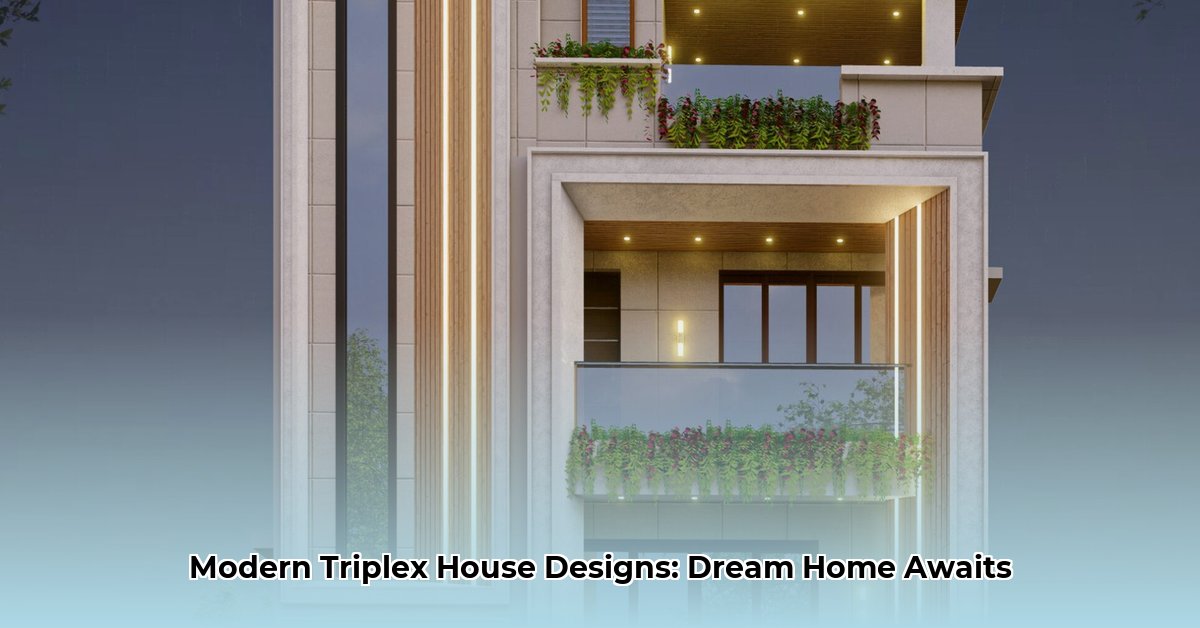Thinking about building a triplex? It’s a smart move – more and more people are looking for this type of housing. This guide will walk you through everything you need to know, from finding the perfect spot and designing a great space to actually building it and finding tenants. We’ll cover the different types of triplexes (fancy or budget-friendly), how to deal with all the rules and regulations, and how to make sure your investment pays off. We’ll even show you real-life examples of successful triplexes to inspire you. For similar modern designs, check out this duplex guide. Let’s get started on building your own successful triplex!
Modern Triplex House Design: A Comprehensive Guide
Building a modern triplex can be a smart investment, but it’s not a walk in the park. This guide helps you navigate the process, from initial concept to happy tenants. Let’s dive in!
Understanding the Market: More Than Just Bricks and Mortar Investments
The demand for modern triplexes is surging. Why? Simply put, single-family homes are becoming increasingly unaffordable for many, pushing people toward multi-unit dwellings. Plus, multigenerational living is trending – families want separate spaces but still wish to be close. This creates huge demand, making triplexes a potentially lucrative investment opportunity. However, success hinges on understanding your local market and navigating the specific regulations in your area. Consider factors like proximity to public transportation, schools, and amenities when choosing a location. A well-located triplex will attract higher-quality tenants and command better rental rates.
Planning and Designing Your Dream Triplex: Tailoring to Your Target Market
Smart planning is critical. Before you even think about blueprints, define your target market. Are you aiming for young professionals, families, or a mix? This decision will significantly influence the design. For example, young professionals might prefer smaller, stylish units with modern amenities, while families might prioritize larger spaces and outdoor areas.
Consider incorporating sustainable features like solar panels and energy-efficient appliances. These are not only good for the environment, but also attract environmentally conscious renters, boost property value, and reduce operating costs. Think open-concept living areas – they create a sense of spaciousness – and private outdoor spaces like balconies or patios. And don’t underestimate the power of visuals! Detailed floor plans and renderings are essential for attracting investors and potential renters, allowing them to visualize the finished product. Considering a design that will maximize property value is key. Ensure your design incorporates adequate soundproofing between units to maintain tenant privacy and satisfaction.
Here’s a quick comparison of design elements for different target markets:
| Design Element | Luxury Triplex | Affordable Triplex |
|---|---|---|
| Materials | High-end finishes, hardwood floors, designer fixtures | Durable, cost-effective materials, efficient fixtures |
| Amenities | In-unit laundry, private balconies, garages, smart home technology | Shared laundry, possibly some outdoor space, basic appliances |
| Unit Size | Larger units, multiple bedrooms and bathrooms | Smaller, efficiently designed units |
| Target Market | High-income earners, young families with high disposable income | Young professionals, students, budget-conscious renters |
| Accessibility | Consider incorporating universal design principles for accessibility. | Ensure compliance with accessibility standards for at least one unit, if required. |
| Technology Integration | Smart home features, high-speed internet access, integrated security systems. | Basic internet access, pre-wiring for cable/satellite. |
Navigating the Regulatory Maze: A Step-by-Step Approach to Building Codes
Local regulations are your biggest hurdle. Failing to comply can lead to costly delays and even project failure. Are you ready to tackle the building codes?
Step 1: Deep Dive into Zoning Regulations: Start with thorough research into your local zoning laws. This includes height restrictions, parking requirements, setbacks from property lines, density limits (the number of units allowed per acre), and any other specific rules for your area. Pay close attention to regulations regarding impervious surface coverage, which can impact landscaping and drainage requirements.
Step 2: Seek Expert Guidance: Don’t go it alone! Consult with a zoning expert or land-use attorney. They can interpret complex regulations, advise on potential challenges, and help you navigate the permitting process. A qualified architect experienced in multi-family dwellings can also be invaluable at this stage.
Step 3: Develop Detailed Plans: Create detailed building plans that meticulously adhere to all zoning requirements. Include accurate measurements, specifications, and detailed renderings. Inaccurate information can cause further delays and conflicts. Ensure your plans address fire safety requirements, including fire-resistant materials and adequate fire exits.
Step 4: The Permitting Process: Expect the permitting process to take time. File your application as early as possible to preempt potential delays. Be prepared to address any concerns or requests from the permitting authorities. Be prepared to submit detailed environmental impact assessments if required by local regulations.
Step 5: Continuous Compliance: Once construction begins, ensure ongoing adherence to all building codes. Regular inspections ensure compliance with the requirements. Any deviation may lead to hefty fines or even project suspension. Schedule regular inspections with the local building inspector throughout the construction process.
Financial Planning and Construction: Budgeting for Success and Profitability
Securing funding is paramount. Explore different financing options, such as conventional loans, private investors, or even government-backed loans designed for multi-family projects. Create a comprehensive, realistic budget. Don’t forget to include a contingency fund – unforeseen expenses are inevitable. Choose efficient construction methods to manage costs effectively. Employing a reputable general contractor and a strong project manager can streamline the building process and help avoid costly mistakes. Using modular construction methods might save you both time and money, depending on the project scope. Remember, building a triplex is a long-term investment; careful planning is key to maximizing profitability. Choosing a smart financing strategy is beneficial for property investment. Consider conducting a thorough cost-benefit analysis of different construction materials and methods to identify the most cost-effective options.
Tenant Management: Attracting and Retaining Quality Residents And Lease Agreements
Attracting and keeping good tenants is crucial for long-term success. Screen potential tenants rigorously, conducting thorough background and credit checks. Ensure you have clear and legally sound lease agreements. Maintain open communication channels and respond promptly to maintenance requests. Building positive relationships with your tenants fosters a stable and profitable rental property. Regular inspections of the property are important for maintaining the property. Consider offering incentives for long-term leases to reduce tenant turnover.
Case Studies: Leaning from the Experts and Regulations
Case studies of successful triplex developments provide invaluable insights. Analyze successful designs which maximize rental income while adhering to local codes and building regulations. Identify common successful strategies, for example, understanding the specific needs of the local market. This is a smart way to avoid costly mistakes. Research case studies in areas with similar demographics and zoning regulations to your project.
Risk Mitigation: Preparing for the Unexpected with Due Diligence
While building a triplex offers high potential returns, risks exist. Market fluctuations, construction delays, unexpected costs, and tenant issues can all impact your bottom line. Thorough planning and a proactive approach are critical to minimizing these risks. Due diligence and meticulous planning are your greatest assets. Obtain comprehensive insurance coverage to protect against potential property damage, liability claims, and loss of rental income.
Conclusion: Building Your Future With Sustainable Building Designs
Building a modern triplex is a complex, but potentially rewarding venture. By carefully understanding the market, planning your design, navigating regulations, securing funding, and implementing sound tenant management strategies, you significantly increase your chances of success. Remember, proactive planning and management are key to maximizing your return on this long-term investment. Stay informed about changes in local zoning regulations and market trends to adapt your strategies as needed.
How to Navigate Zoning Regulations for Triplex Development
Key Takeaways:
- California’s recent legislation simplifies converting single-family homes into triplexes, primarily focused on Accessory Dwelling Units (ADUs).
- Navigating the interplay between state regulations and local ordinances remains crucial, especially given the potential for local resistance.
- Understanding the financial and legal implications, including potential legal battles, is vital for successful triplex development.
- Thorough planning and adherence to building codes are essential to avoid delays and legal issues.
Understanding California’s Triplex Landscape and Financial Investment
California’s housing crisis fuels the growing interest in triplexes. They offer a solution, increasing housing density while potentially boosting property values. But, how do you successfully navigate the process? It’s a journey that requires careful planning and an understanding of both state and local regulations. Analyze the potential return on investment (ROI) based on projected rental income and property appreciation.
Mastering the Art of How to Navigate Zoning Regulations for Triplex Development and Municipal Codes
The path to triplex development in California is paved with both opportunities and challenges. The state has streamlined ADU permitting, offering a much simpler process than before. However, local governments retain some control, potentially creating roadblocks even with the new laws. It’s like weaving through a complex regulatory web; are you up for the challenge?
Step 1: Researching Local and State Regulations
First, thoroughly research relevant state and local zoning codes. California’s laws are designed to ease the process, but each city or county may have specific requirements regarding setbacks, lot sizes, parking, and design. Knowing these rules upfront prevents delays and costly changes later. Utilize online resources and databases to access zoning maps and
- Kitchen Backsplash For White Kitchen: Ideas To Inspire Your Renovation - November 21, 2025
- White On White Kitchen Backsplash: Is It Timeless? - November 20, 2025
- Backsplash Colors for White Cabinets: Find Your Perfect Match - November 19, 2025










